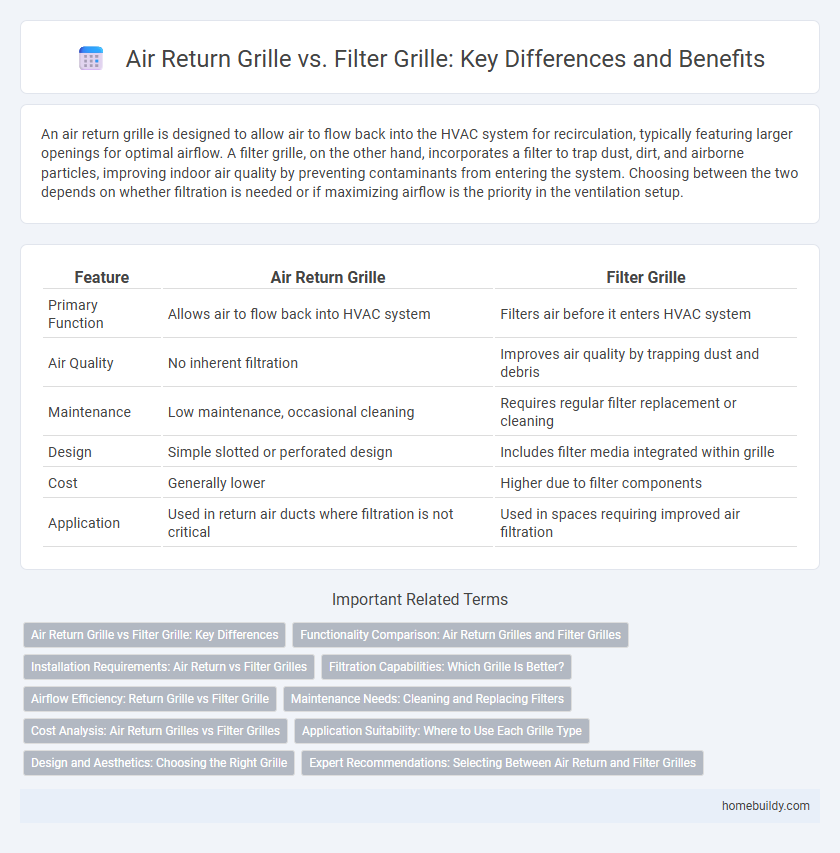An air return grille is designed to allow air to flow back into the HVAC system for recirculation, typically featuring larger openings for optimal airflow. A filter grille, on the other hand, incorporates a filter to trap dust, dirt, and airborne particles, improving indoor air quality by preventing contaminants from entering the system. Choosing between the two depends on whether filtration is needed or if maximizing airflow is the priority in the ventilation setup.
Table of Comparison
| Feature | Air Return Grille | Filter Grille |
|---|---|---|
| Primary Function | Allows air to flow back into HVAC system | Filters air before it enters HVAC system |
| Air Quality | No inherent filtration | Improves air quality by trapping dust and debris |
| Maintenance | Low maintenance, occasional cleaning | Requires regular filter replacement or cleaning |
| Design | Simple slotted or perforated design | Includes filter media integrated within grille |
| Cost | Generally lower | Higher due to filter components |
| Application | Used in return air ducts where filtration is not critical | Used in spaces requiring improved air filtration |
Air Return Grille vs Filter Grille: Key Differences
Air return grilles primarily facilitate the flow of air back into HVAC systems, ensuring proper circulation without incorporating filtration, while filter grilles combine airflow functionality with built-in filters to trap dust and debris. The design of air return grilles emphasizes ventilation efficiency, whereas filter grilles prioritize improving indoor air quality by capturing airborne contaminants. Understanding the distinction between an air return grille and a filter grille is essential for optimizing HVAC performance and maintaining cleaner air environments.
Functionality Comparison: Air Return Grilles and Filter Grilles
Air return grilles primarily facilitate airflow circulation by allowing return air to flow back into HVAC systems, maintaining system efficiency and indoor air quality. Filter grilles combine airflow functionality with integrated filtration, trapping dust and airborne particles to improve air purity while allowing return air passage. Choosing between an air return grille and a filter grille depends on whether the priority is maximizing airflow or enhancing particulate filtration within the HVAC system.
Installation Requirements: Air Return vs Filter Grilles
Air return grilles require installation in locations that ensure optimal airflow back to the HVAC system, typically in ceilings or high on walls to promote effective air circulation. Filter grilles demand secure mounting that accommodates filter replacement, often featuring snap-in or hinged frames for easy access. Proper sealing and alignment are crucial for both to prevent air leakage and maintain system efficiency.
Filtration Capabilities: Which Grille Is Better?
Air return grilles primarily allow airflow back to the HVAC system with minimal filtration, while filter grilles incorporate built-in filters that capture dust, pollen, and other airborne particles. Filter grilles provide superior filtration capabilities by improving indoor air quality and reducing system contamination, making them more effective in environments requiring cleaner air. For enhanced filtration performance, filter grilles are the preferred choice over standard air return grilles.
Airflow Efficiency: Return Grille vs Filter Grille
Air return grilles are designed to maximize airflow efficiency by providing a low-resistance path for air to re-enter the HVAC system, ensuring optimal circulation and reducing energy consumption. Filter grilles, while incorporating filtration media to improve air quality, often restrict airflow due to the added filter elements, which can increase system pressure and reduce overall ventilation performance. Selecting an air return grille instead of a filter grille is ideal when the priority is maximizing airflow efficiency, though filter grilles are beneficial where air purification is necessary.
Maintenance Needs: Cleaning and Replacing Filters
Air return grilles require regular cleaning to prevent dust accumulation that can obstruct airflow and reduce HVAC efficiency. Filter grilles incorporate replaceable or washable filters that must be maintained according to manufacturer guidelines to ensure optimal air quality and system performance. Unlike standard air return grilles, filter grilles demand more frequent attention for filter replacement or washing to maintain proper filtration levels.
Cost Analysis: Air Return Grilles vs Filter Grilles
Air return grilles typically have lower initial costs compared to filter grilles due to their simpler design and lack of integrated filtration media. Filter grilles require periodic replacement of filters, increasing long-term maintenance expenses, while air return grilles mainly involve minimal cleaning costs. Evaluating total ownership cost, air return grilles offer upfront savings but may necessitate additional HVAC system filtration to maintain air quality.
Application Suitability: Where to Use Each Grille Type
Air return grilles are ideal for HVAC systems requiring efficient airflow return with minimal resistance, commonly installed in walls or ceilings to facilitate overall air circulation. Filter grilles combine airflow return with filtration, making them suitable for environments demanding improved indoor air quality, such as hospitals and clean rooms. Choosing between air return and filter grilles depends on whether the priority is maximizing airflow or enhancing air filtration within the ventilation system.
Design and Aesthetics: Choosing the Right Grille
Air return grilles feature functional louvers designed to maximize airflow while maintaining a minimalist appearance, ideal for modern HVAC systems. Filter grilles integrate both air intake and filtration into a single unit, often resulting in a bulkier design that emphasizes practicality over sleek aesthetics. Selecting between air return and filter grilles depends on balancing the desired airflow efficiency with the visual impact on interior design.
Expert Recommendations: Selecting Between Air Return and Filter Grilles
Experts recommend choosing an air return grille for efficient airflow and reduced pressure drop in HVAC systems, ensuring better system performance. Filter grilles are ideal when dust control and air quality improvement are priorities, as they integrate filtration directly into the return path. Selecting between air return and filter grilles depends on balancing airflow efficiency with filtration needs based on building-specific air quality requirements.
Air return grille vs Filter grille Infographic

 homebuildy.com
homebuildy.com